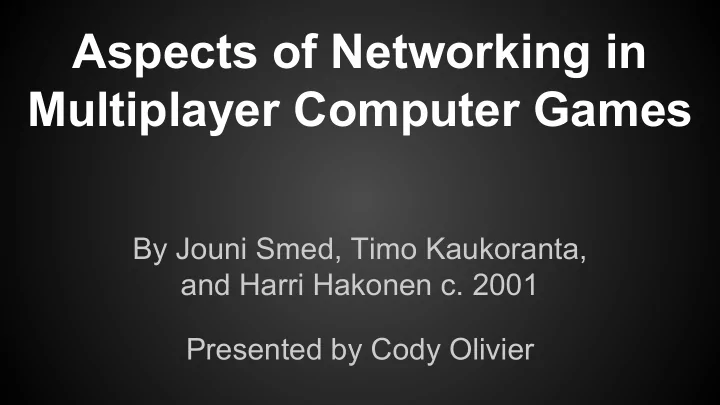

Aspects of Networking in Multiplayer Computer Games By Jouni Smed, Timo Kaukoranta, and Harri Hakonen c. 2001 Presented by Cody Olivier
Intro / Motivation ● Virtual reality realm of computing: ○ c1980 Military Simulations ■ Distributed Interactive Simulation ( DIS ) ○ c1990 Virtual Reality ■ Distributed virtual environments ( DVE ) ○ c1990 Computer Supported Collaborative Work
Intro / Motivation ● Share similarities with online games ● Games not seen in scientific literature ● Game companies starting to publishing ideas ● Bridge gap: Layout explicit problems
Topics ● Networking Resources ● Distributed Concepts ● Scalability ● Security and Cheating
Networking Resources ● Bandwidth ○ Amount of data sent per unit time ● Latency ○ Jitter: variance in latency ○ Rule of Thumb: 0.1 - 1 sec ● Computational Power ○ Handling traffic ○ 100,000 objects ⇒ 80 percent CPU 500Mhz processor
Topics ● Networking Resources ● Distributed Concepts ● Scalability ● Security and Cheating
DC - Communication Architectures ● Split Screen ● Peer-to-Peer ○ Great for LAN ● Client / Server ○ Very common today ● Server - Network ○ Upgrade: hierarchy of server-network
DC - Data and Control Architectures ● Data and Control Attributes ○ Consistency: same data everywhere ○ Responsiveness: how responsive are changes ● 2 setups: ○ Two-way relay ■ Commands sent directly to server ○ Short-Circuit ■ Send to server and locally updated
DC - Data and Control Architectures ● Architectures: ○ Centralized ■ All data on one server ■ Consistency, two-way relay ○ Distributed ■ Subsets of data on a server ■ Responsiveness, short-circuit relay ○ Replicated ■ Duplicates of data ■ Responsiveness, short-circuit relay
DC - Compensatory Management ● Reducing traffic between nodes ● Message Compression and Aggregation ○ Compress data ○ Aggregating messages ■ Less header info ● Tradeoff - less data sent, more computation
Interest Management ● Nodes express interest in what they want ● Aura or area of interest ○ Only send relevant data to clients ○ 2 entity auros intersect, made aware of each other ○ Symmetric
Interest Management ● Finer grade: nimbus and focus ○ When Focus intersects other entity nimbus, update
Dead Reckoning ● Predicting future data ○ Based on navigational techniques ● Position and velocity known, extrapolate future positions ● Increase time between transmissions ● Update when new messages are arrive
Topics ● Networking Resources ● Distributed Concepts ● Scalability ● Security and Cheating
Scalability - Serial & Parallel Execution ● Speedup based on # nodes and parallel part ● Serializable part immutable ● Extreme 1: no serialize part exists ● Extreme 2: no parallelizable part ● Real-time must be between these ● Client / Server works best
Scalability - Communication Capacity ● Serialized scalability communication limited ● P2P Server-Network: n clients, m servers ● Hierarchical Server-Network: ~n capacity
Ultimate Hierarchical Server-Network ● Sublinear communications ● k-ary tree of hierarchical server-network ● Server sends 1/kth of client data up the tree ○ Aggregation and compression ■ Very unlikely to reduce data to 1/kth ○ Instead, perform interest management ○ Use dead reckoning to limit messages sent
Topics ● Networking Resources ● Distributed Concepts ● Scalability ● Security and Cheating
S&C - Packet and Traffic Tampering ● Issues ○ Reflex Augmentation ○ Packet Interception ○ Replay Attack ● Solutions: ○ Use checksums ( MD5 ) to detect packet tampering ○ Encrypt and add state information ( such as random numbers )
S&C - Information Exposure ● Crack clients ○ RTS: see where other players’ units are ○ FPS: wallhacks ● Solution: ○ Data encrypted, memory locations hard to find ○ Make sure commands coming into server are valid ○ In replicable arch, determine what is valid by majority
S&C - Design Defects ● Exploits ● Backend design choices ○ Client trust ○ Solution: Server commands ( not checksums ) ● Unexpected issues: ○ Latency is high ○ DDOS
Topics ● Networking Resources ● Distributed Concepts ● Scalability ● Security and Cheating
Conclusion ● Provide overview of multiplayer game networking topics ● Future work: ○ Test different aspects of released games ○ Look into upcoming encryption for better security ○ Inform game makers of advances in research
Recommend
More recommend